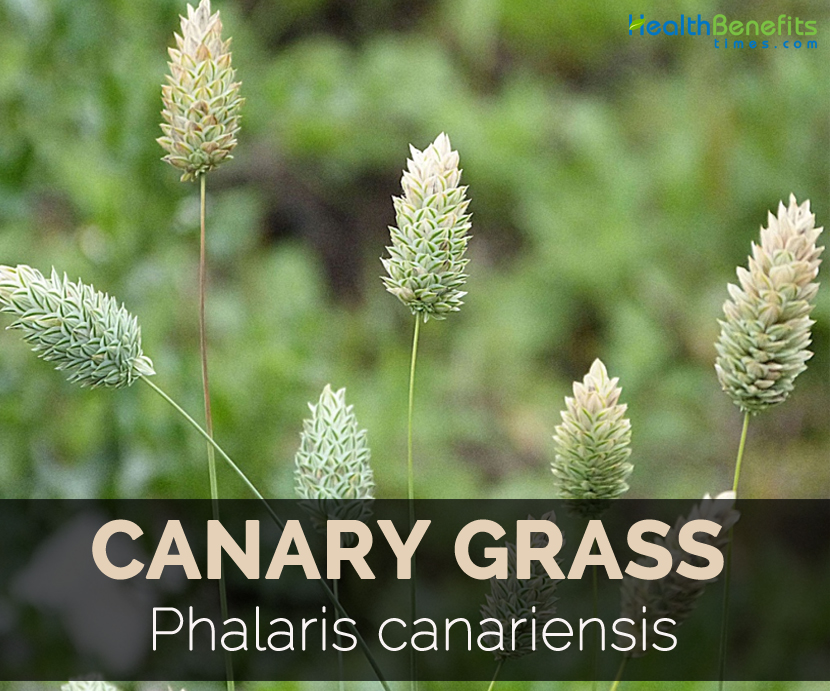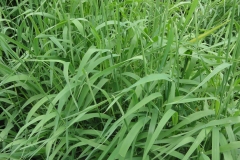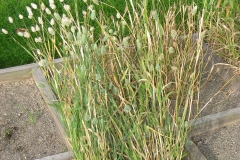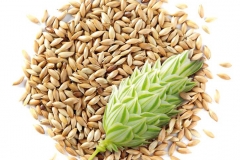 Canary grass, Phalaris canariensis, is a shrubby plant that belongs to Poaceae family. It is native to Mediterranean region. It is mostly cultivated in Argentina and Canada. It is regarded as a promising cereal for human consumption due to its nutrients and nutraceutical value as well as for industrial purposes. It is commercially grown in various parts of world for birdseed.
Canary grass, Phalaris canariensis, is a shrubby plant that belongs to Poaceae family. It is native to Mediterranean region. It is mostly cultivated in Argentina and Canada. It is regarded as a promising cereal for human consumption due to its nutrients and nutraceutical value as well as for industrial purposes. It is commercially grown in various parts of world for birdseed.
The coarse grass has erect and hairless stems usually 2 to 6 feet (0.61 to 1.83 meters) tall. Ligule is membranous and prominent about ¼ inches (0.64 cm) long and rounded at apex. The tapering leaf blades are 3 ½ to 10 inches (8.9 to 25.4 cm) long 1/4 to ¾ inches (0.64 to 1.91 cm) wide, flat and often harsh on both surfaces. Panicles are erect and sometimes slightly spreading ranging from 3 to 16 inches (7.6 to 40.6 cm) long with ½ to 1 ½ inches (1.3 to 3.8 cm) long. The flowers occur in dense clusters in May to mid-June or August. Initially, inflorescences are green or slightly purple then it becomes tan. Seeds are shiny brown. Seeds are also used as bird food and mixed with rapeseed and other seeds that cheapen it. It is kept in a dry place and away from vermin.
It is one of the top four specialty crops cultivated in western Canada with over 400000 acres planted in this region. It extent throughout the entire northern hemisphere specifically in Asia, North America, Europe and North Africa. It prefers soils rich in nutrients with slightly acidic to neutral pH and also in wetlands. Usually, it is used in folk medicine for diabetes and hypertension treatments.
Health Benefits of Canary grass
- Cholesterol reduction
Lipase enzyme helps to reduce cholesterol and triglyceride levels due to its cleansing effect on veins. It is helpful in preventing hypercholesterolemia. Take an infusion of Canary seeds for three days. Add a spoon of canary seed in a cup of boiling water and let it boil for four minutes. Remove it from heat and let it to stand. Filter it and drink.
- Lose weight
Canary seed assist in losing weight. The lipase content makes it effective to include in diet. This enzyme helps to eliminate body fat. Moreover, it acts as a diuretic and food purification so it is consumed to eliminate liquids and toxins. Its fiber content helps to prevent constipation.
- Reduce inflammation
Canary seed has anti-inflammatory properties which are found to be beneficial for kidneys, liver and pancreas. It is also a cure for bladder and kidney conditions such as cystitis. It reduces inflammatory proteins known as cytokines. It also lowers buildup of neutrophils, a white blood cell that accumulates during inflammation and has a crucial role in the development.
- Enhance mood
It has tryptophan which shows antidepressant effect. The amino acid activates serotonin production which is known as hormone that enhance good mood and improve mental state.
- Reduce blood pressure
In America, heart disease is the major cause for death. High blood pressure is the major cause for this disorder. Canary seeds can maintain normal blood pressure. The animal study shows that seed proteins inhibit angiotensin converting enzyme. Excess presence of this enzyme causes constriction of blood vessels resulting high blood pressure. This seeds also promotes production of nitric acid, a compound that helps to widen blood vessels. It also reduces blood pressure and heart rate.
- Oxidative stress
Canary seeds have high content of antioxidants. It has several polyphenols and ferulic acid is the most abundant polyphenols in it. Antioxidants help to eliminate free radicals, harmful molecules which is responsible for cell damage known as oxidative stress. Oxidative stress has a crucial role in diabetes, heart disease and Alzheimer’s disease.
- Lowers obesity
Obesity is directly associated with heart disease, cancers and type 2 diabetes. People with obesity should add canary seed to the diet as it pumps brakes on carbohydrate and lipid absorption. It inhibits obesity related enzymes such as lipoprotein lipase as well as pancreatic lipase. Canary seeds help in preventing weight gain.
- Maintains blood glucose levels
Diabetes has become the seventh leading cause of death in the country. Add canary seeds to the diet to maintain normal blood glucose levels. It suppresses the carbohydrate absorption by acting on certain enzymes. It prevents diabetes and also manages so that the blood glucose won’t spike rapidly. Add it to the diet by sprinkling it on food, add it to smoothies or have it straight from the pack.
Culinary uses
- Cook the seeds or use it as a cereal to make porridge.
- Ground it into flour and use for making puddings and cakes.
- Young leaves are cooked as vegetables.
References:
https://www.itis.gov/servlet/SingleRpt/SingleRpt?search_topic=TSN&search_value=41336#null
https://pfaf.org/user/Plant.aspx?LatinName=Phalaris+canariensis
https://en.wikipedia.org/wiki/Canary_grass
https://en.wikipedia.org/wiki/Phalaris_arundinacea
https://wiki.bugwood.org/Phalaris_canariensis/NJ
https://www.cabi.org/isc/datasheet/55423#tosummaryOfInvasiveness
https://species.wikimedia.org/wiki/Phalaris_canariensis
https://species.nbnatlas.org/species/NBNSYS0000002670
https://pdfs.semanticscholar.org/787a/2b8e506fc00863a5e4cd27a6cfd47bf57d23.pdf
http://www.florajournal.com/archives/2017/vol5issue5/PartA/6-3-1-296.pdf
https://plants.usda.gov/core/profile?symbol=PHCA5
https://fromdoctor.com/benefits-and-properties-of-canary-seed.html










